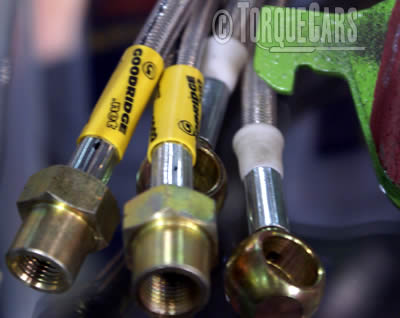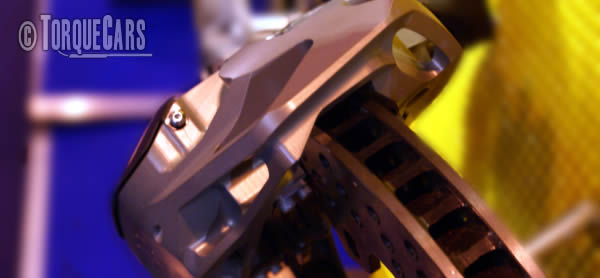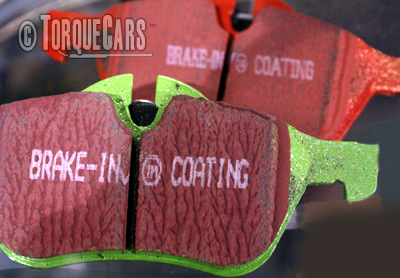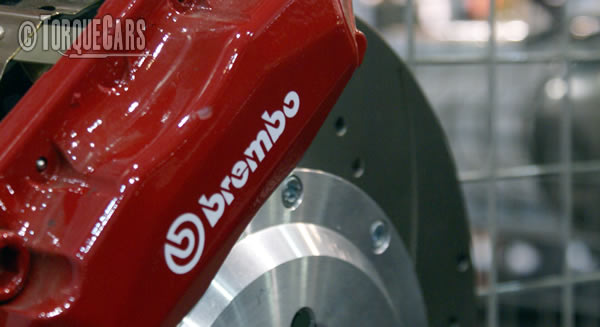How to improve your cars braking.
"Thanks for reading our ultimate guide to brake upgrade kits"

Brakes should never be overlooked – a big part of going fast requires that one is able to stop quickly too!
A brake works with a friction pad, which when pressed against the Disc converts the kinetic energy into heat.
This heat it then dissipated and the cars forward momentum is slowed up.
Heat build up is a big problem with heavy braking and if you've ever watched motorsports at night you see the brakes glowing with heat after a lot of use.
NB: Big Brakes Are Not The Biggest Stopping Factor
The grip you have is the primary factor that determines how quickly you stop. Although kinetic energy is converted into heat, the primary slowing factor comes from your rubber and it's contact with the road surface.
Providing your brakes can cause the wheels to lock up they are sufficient to stop you effectively, but some drivers will benefit from a brake upgrade kit and we will discuss all you need to know about brakes and stopping power in this article.
A larger brake will generally allow more "feel" and you'll have greater control over the stopping through pressure on the brake pedal.
Smaller brakes tend to lock up very quickly and unless you have ABS to manage this it can be quite tricky to cadence (pulse) brake yourself to keep the brake at the point before lockup.
How do brakes work?
When you press the brake pedal this force goes from into a magic box called a servo, and this uses engine power to amplify the pressure of your foot decreasing the effort you need to expend and gives a nice progressive feel.
The additional pressure is transferred to the friction pads by means of liquid (brake fluid) inside a tube (liquids do not compress like air).
At the brake pad end, which is subject to high temperatures, the fluid itself can get very hot so demands are made on even the brake fluid.
The wheel will then slow up and create drag on the road surface and the car will slow up. This is much like pushing your foot on the ground when you were riding a bicycle, it causes drag and slows you up, but when the wheel locks up this friction is reduced, so you want to keep the cars braking friction just before the point of lock up for the most effective stopping power.
Is brake fluid spec important?
The benefits of using a liquid, which cannot be easily pressurised, means that the effect of braking passes along the tube (brake pipes) almost instantly and very little is lost along the way.
A cable would stretch a little and needs constant adjusting – most handbrakes use a cable system so you are aware how inefficient the cable brake system is also cables are more susceptible to the effects of heat and stretching.
The problem with brake fluids are that they are hygroscopic (they draw in water particles) which reduce the effectiveness of the transference process also at high temperatures they can boil – bubbles of air in the brake fluid create a spongy effect at least or at worst can completely prevent the brake from having any effect.
(See the article on Brake Fade for more details of this phenomenon and how it can be avoided.)
What are the brake components?
So what recommendations would TorqueCars make to someone wanting to improve their cars braking?

The braking heat dissipates from the pad over the discs so the better the disc at cooling the more effective it will be.
Enter the vented disc which has a central channel which increases the surface to air ratio of the disc and creates much better and faster cooling.
Drilled discs also increase the air ratio and along with grooves help to prevent a gas build up between the pad and the disc and the drilled holes help to keep the pads ‘clean and sharp’.
Bigger discs = better cooling but bigger discs may require a different style of alloy wheel.

Brake pad materials.
The brake pads though are an essential part – the higher the friction the better although they can create noise and dust.
Brake Lining Composition
Brake linings used to be constructed with Asbestos (now discontinued). The following materials (in the ascending order of their prices) are now used for this purpose:
- Organic;
- Semi-metallic;
- Metallic;
- Ceramic;
- Carbon Ceramic.
Are cheap organic pads worth considering?
Yes they can be very effective, and cost just a fraction of the more expensive options.
The organic materials used for the brake lining purpose include:
- Glass;
- Kevlar;
- Rubber;
- Resin;
- Fibre.
Racing pads are specially constructed from a high friction compound which works at much higher temperatures as a consequence it will be ineffective when cold.
Motorsports race brake pads will start working effectively only when very hot so this renders race spec pads useless for the road where braking most often happens on cold pads or for very short bursts.
TorqueCars have found that fast road pads such as those supplied by Pagid and Black Diamond are a very good compromise and give improved braking and good wear properties.
Some makes of performance pads have the added benefit of producing nearly zero brake dust and even last longer than the standards pads I was using – although driving style will effect the wear on the pad and on your discs.
Benefits of ABS
ABS prevents a skid under lockup conditions by releasing the brake until the wheel rotates again. This effectively reduces the braking force to your current level of grip.
Due to weight distribution changes under steering you effectively reduce your wheel locking resistance so steering will reduce the braking efficiency as the ABS cuts in more to compensate.
ABS on gravel and snow can actually be a problem as the brakes are cut due to loss of traction whereas if the wheels where slowed a little the car could stop more quickly.
Rally cars have a custom ABS setup which is quite different to standard road cars and maintains control and braking efficiency on gravel surfaces.
A good quality brake will be less prone to lock up and offers better stopping power even when ABS is fitted.
If you are not a competent mechanic Torquecars recommend that you leave brake work to the specialist as a failure would result in a certain accident.

Guide to Brake upgrades.
You can do a lot to improve a cars stopping power.
Typically you'd fitting bigger discs (rotors) and better pads.
As a larger disc will have a greater friction area and will dissipate more heat you will benefit immediately with more control over braking, and a brake that is less prone to experience fade.
Watch our video on Choosing and buying Brakes on our YouTube channel.
You will also notice you have more feel and it is easier to detect the point of lock up with a large disc conversion kit.
Taking a standard family car with relatively small discs, as an example, an easy and cheap route would be to visit the breakers yard and get brake disks and servos from a performance model from the same family.
For example a basic small family car will usually upgrade to the performance versions brakes (if these fit into the alloy wheels or you'll need to get larger rims.
Often small cars share similar part specifications to the larger executive counterparts so a little research and chatting with our forum members will point you in the right direction. Brakes across VW Audi Porsche Skoda and Seat are generally interchangeable as most hubs are the same or you can swap out the hubs easily.
The calipers (these apply the clamping force) and pistons (which push the calipers) next come in for attention. The more pistons you have the greater the clamping force you'll get and this will allow the use of much larger pads.
When swapping to larger calipers
If you are intending to use brake calipers from another make or larger vehicle that has 4 or more pistons it is not as easy as making a dog bone adapter to mount them onto the factory (or larger discs) to replace the factory single piston sliding calipers!
It is imperative that the total volume of fluid used when the brakes are applied be equal to the amount used in the donor cars master cylinder when the brakes are applied.
If you don't do this the pedal feel and stroke will be different and the pedal will almost certainly go closer to the floor before the brakes work.
To get the pedal engagement at the same height as factory may require over boring the factory brake master cylinder to increase its volume to match the donor vehicle's master cylinder OR replacing it with a larger unit to get the fluid volume displacement correct.
TorqueCars see little point of adding more pistons or a larger brake pad, to a standard size disc as the heat dissipation ability of the disc will be impaired by the larger pads used.
When upgrading the discs you should also look into increasing the pad, caliper and number of pistons for best effect.
General maintenance & care.
When driving through floods apply the brakes briefly to dissipate the water and grease that gets on them and this will dramatically improve your chances of stopping in an emergency situation.
Once a year or if you notice the brakes losing their effectiveness you should rough up the disc surface with abrasive steel wool or similar this will stop the ultra smooth mirrored surface you see on gently driven family runaround cars.
This will brake the glaze and help the pad to bite the disc more effectively. You should always check your pads for wear and if you are preparing for a track day TorqueCars recommend fitting new pads as these will take a lot of abuse.
Check the brake discs for wear by measuring the thickness and ensure that a wear ridge is not appearing on the outside.
Thin brake discs can warp or under heat stress can brake causing a wheel lockup so it really is a false economy to run with worn discs.
Brake fluid should also be frequently checked and changed annually to bi-annually depending on your driving style and the recommended service interval for your car.
Brake fluid should be checked ideally by a specialist for its boiling point which gives an idea of its degradation.
Synthetic (DOT5 - UK spec) brake fluids are not hygroscopic and have extremely high boiling points.
Stainless steel braided hoses prevent any flexing and therefore loss of pressure at the pad end, they also look nicer and theoretically last longer too – get a full set and do front and back at the same time.
Please join us in our friendly forum to catch up with the latest trends in brake upgrades, car tuning and car modification for your car model.
Please Check out my YouTube channel, we're regularly adding new content...
PLEASE HELP: I NEED YOUR DONATIONS TO COVER THE COSTS OF RUNNING THIS SITE AND KEEP IT RUNNING. I do not charge you to access this website and it saves most TorqueCars readers $100's each year - but we are NON PROFIT and not even covering our costs. To keep us running PLEASE Donate here
If you liked this page please share it with your friends, drop a link to it in your favourite forum or use the bookmarking options to save it to your social media profile.
Feedback - What do You Think?
Please use our forums if you wish to ask a tuning question, and please note we do not sell parts or services, we are just an online magazine.
Help us improve, leave a suggestion or tip
Please watch this video and subscribe to my YouTube channel.
One Response to “Brake upgrade kits.”

 Click to accept YouTube Cookies & Play.
Click to accept YouTube Cookies & Play.
ABS “helps prevent lockups”is actually misleading as it prevents the locked wheel from staying locked and doesn’t activate until a wheel is locked .